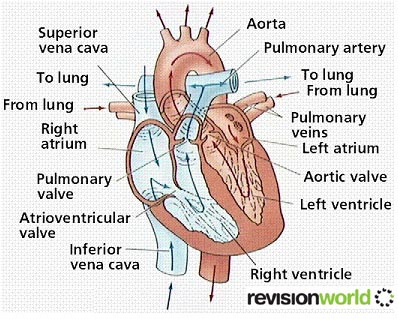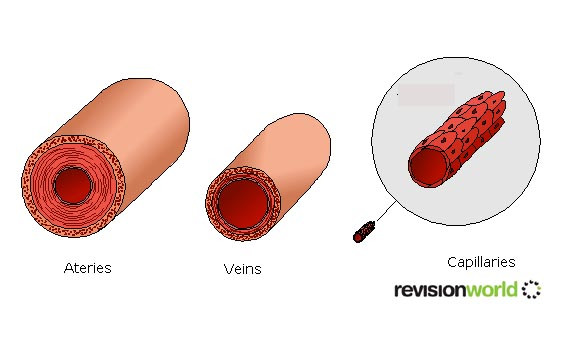Circulatory System & Heart
After studying this section you should understand
- Circulatory System Functions
- Blood Pressure
- Aerobic Training
- The Heart
- Transportation of Blood
Circulatory System Functions
The Circulatory system has 3 functions:
- Transport - Moving things around the body in the bloodstream, such as O2, nutrients, water and waste
- Controls Body Temperature - More blood near the skin cools the body quicker
- Protection - Moving antibodies around the body to fight disease.
Humans have a double circulation. Each time blood goes around your body it goes through the heart twice (double circulation). This happens because there are 2 circuits:
1. The systemic circuit – this is the main circuit which carries oxygenated blood around the body in the arteries, and deoxygenated blood back to the heart along the veins
2. The pulmonary circuit – this includes the heart and lungs, and carries deoxygenated blood from the heart to the lungs to be oxygenated.
Oxygenated blood – has more O2, and found in all arteries (except pulmonary artery)
Deoxygenated blood – has less O2, and is found in all veins (except pulmonary vein)
Blood Pressure
Blood pressure gives us two readings:
1. Systolic pressure – pressure of the blood in the arteries when the left ventricle contracts
2. Diastolic pressure – pressure of the blood in the arteries when the left ventricle relaxes
It can be affected by many things:
- Age – increases with age
- Gender – generally higher in men
- Exercise – reduces in long term increases in short term
- Stress – increases
High Blood Pressure
If your blood pressure remains high, you could be at risk from the following:
- Angina – sharp pains in the chest, caused by the heart not getting enough oxygen
- Heart attacks – the heart stopping because it is starved of oxygen
- Strokes – damage to the brain due to no Oxygen
Aerobic Training
Aerobic training can help in the following ways:
- Your body makes more red blood cells, so it can transport more O2
- Your arteries get bigger so your blood pressure falls
- More capillaries form in the muscles, so O2 is delivered better
- Your heart gets bigger, and the walls get thicker
- After exercising, your heart rate falls back to normal quicker
The Heart
The heart is a four-chambered muscular pump which pumps blood round the circulatory system.
The right side of the heart pumps de-oxygenated blood to the lungs to pick up oxygen.
The left side of the heart pumps the oxygenated blood from the lungs around the rest of the body.

1. Deoxygenated blood enters through the vena cava into the right atrium
2. It’s then pumped through a valve into the right ventricle chamber
3. And then up through the pulmonary valve into the pulmonary artery towards the lungs
4. Oxygenated blood enters through the pulmonary veins into the left atrium
5. It’s then pumped through a valve into the left ventricle
6. And then through the aortic valve and out of the aorta to the rest of the body
This video explains how the heart works
How the Blood is transported

There are 3 types of blood vessel:
- Arteries - Carry oxygenated blood away from the heart. Have thick, strong, elastic walls to cope with the pressure. Small arteries are called arterioles.
- Veins - Carry deoxygenated blood back to the heart. Have thinner walls, because the blood is a lower pressure. Have valves to keep the blood going on the right direction. Small veins are called venules
- Capillaries - Carry food and oxygen directly to the tissues, and take the waste away from them. Very small, with very thin walls.
Red Blood Cells - Carry oxygen around the body. They have no nucleus
White Blood Cells - Fight against disease by destroying bacteria, toxins and foreign microbes
Plasma - Carries everything in the bloodstream, including cells, digested food, water, hormones
Platelets - Small fragments of cells with no nucleus, which help to clot wounds
